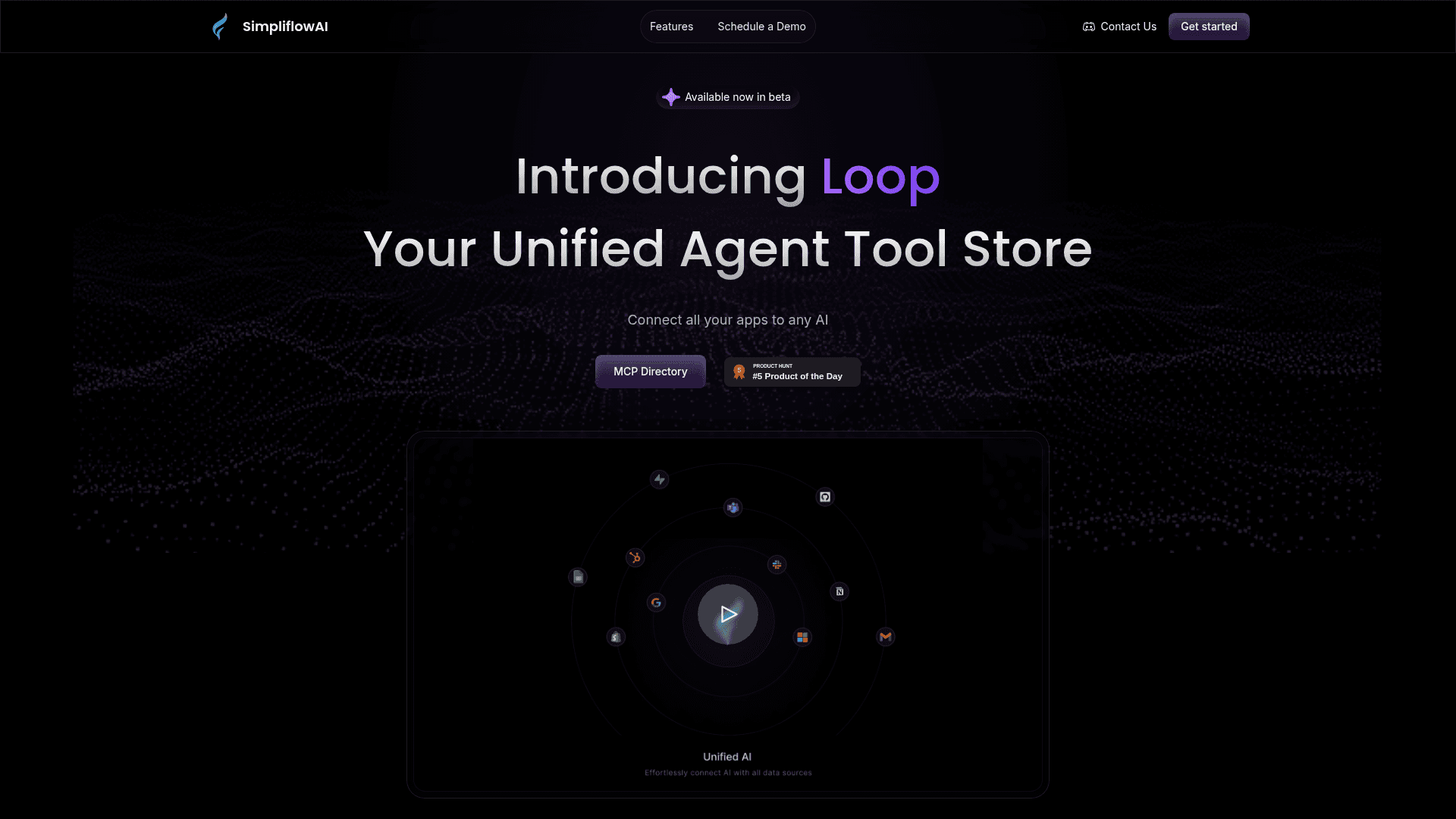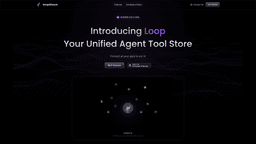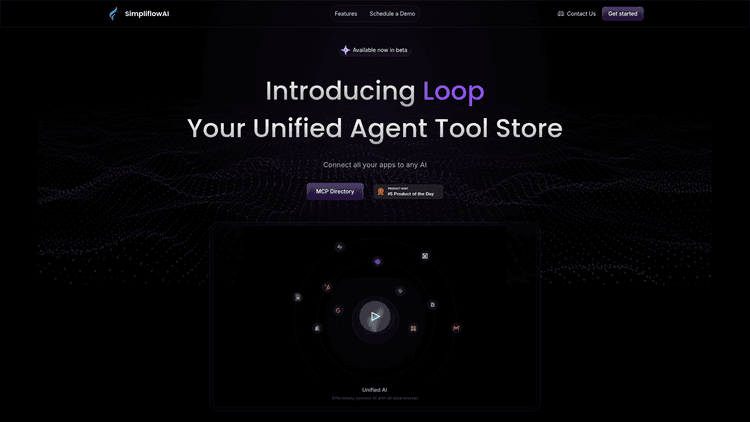



Loop
Product Overview
Loop emerges as a sophisticated AI workflow management platform designed to address one of the most pressing challenges in modern AI adoption: the complexity of integrating and managing multiple AI tools effectively. Think of Loop as the conductor's baton that brings order to the chaos of disparate AI applications scattered across your digital workspace.
At its core, Loop serves as a centralized hub that connects, orchestrates, and streamlines various AI tools and services through what the company calls a "Unified MCP Gateway." This isn't just another dashboard – it's a comprehensive ecosystem that transforms how professionals interact with AI technology. The platform essentially acts as a universal translator between different AI services, eliminating the friction that typically occurs when switching between tools or trying to create cohesive workflows across multiple platforms.
What sets Loop apart from traditional AI management solutions is its focus on seamless integration rather than replacement. Instead of forcing users to abandon their favorite AI tools, Loop embraces them, creating bridges that allow these tools to communicate and work together harmoniously. This approach resonates particularly well with organizations that have already invested in various AI solutions but struggle with the operational overhead of managing them effectively.
Features and Benefits of Loop
Loop's feature set reads like a wish list from AI professionals who have experienced the pain points of fragmented workflows firsthand. The platform's Unified MCP Gateway serves as the cornerstone technology, enabling what can best be described as "AI orchestration at scale."
The primary feature that catches attention is Loop's ability to create seamless connections between disparate AI services. Whether you're working with natural language processing tools, image generation platforms, or data analysis services, Loop acts as the universal adapter that makes them speak the same language. This connectivity isn't just about API integration – it's about creating intelligent workflows that can adapt and respond based on context and user behavior.
One particularly impressive aspect of Loop is its workflow automation capabilities. Users can design complex, multi-step processes that span across different AI tools without the traditional headaches of manual coordination. For instance, a marketing professional could set up a workflow that automatically generates content ideas using one AI tool, creates visual assets through another, and optimizes the final output using a third – all within a single, orchestrated process.
The platform also excels in what could be called "intelligent routing." When you submit a request through Loop, the system analyzes the nature of your task and automatically directs it to the most appropriate AI service within your connected ecosystem. This means you don't need to become an expert in every tool you use – Loop handles the complexity while you focus on the creative and strategic aspects of your work.
Another standout feature is Loop's unified interface design. Rather than forcing users to learn multiple interfaces, Loop provides a consistent experience regardless of which underlying AI service is handling your request. This consistency dramatically reduces the learning curve and cognitive load associated with managing multiple AI tools.
The platform's monitoring and analytics capabilities deserve special mention as well. Loop provides comprehensive insights into how your AI tools are being utilized, where bottlenecks occur, and which combinations of services deliver the best results for specific types of tasks. This data-driven approach enables continuous optimization of AI workflows, something that's nearly impossible to achieve when managing tools in isolation.
Market Applications and User Experience
Loop has found its sweet spot among organizations and professionals who live at the intersection of AI adoption and operational efficiency. The platform's user base spans across several key demographics, each drawn to Loop for slightly different but complementary reasons.
Enterprise teams represent a significant portion of Loop's user community. These organizations typically struggle with what industry experts call "AI tool sprawl" – the accumulation of various AI services that, while individually powerful, create operational complexity when used together. Marketing departments, for instance, might use separate AI tools for content generation, image creation, social media optimization, and performance analytics. Loop transforms this fragmented approach into a cohesive system where these tools work together seamlessly.
Digital agencies and consulting firms have also embraced Loop enthusiastically. These businesses often need to deliver AI-powered solutions to clients while maintaining efficiency and consistency across projects. Loop's Unified MCP Gateway enables these agencies to standardize their AI workflows without sacrificing the flexibility to choose the best tools for each specific client need.
Individual AI practitioners and power users form another core segment of Loop's audience. These professionals often juggle multiple AI subscriptions and have developed complex workflows that span across different platforms. Loop allows them to maintain their preferred tool stack while eliminating the friction of manual coordination and context switching.
The user experience within Loop reflects a deep understanding of how AI professionals actually work. The onboarding process focuses on connecting existing AI services rather than requiring users to learn entirely new tools. This approach significantly reduces the barrier to entry and allows users to see immediate value from their Loop implementation.
Users frequently highlight Loop's ability to maintain context across different AI interactions as a game-changer. In traditional workflows, moving from a language model to an image generator often means starting fresh with context and parameters. Loop preserves this context, enabling more sophisticated and nuanced AI workflows that would be impractical to manage manually.
FAQs About Loop
What exactly is Loop's Unified MCP Gateway and how does it work?
Loop's Unified MCP Gateway functions as a centralized orchestration layer that connects and coordinates multiple AI services. Think of it as a smart router that understands the capabilities of different AI tools and can automatically direct tasks to the most appropriate service while maintaining context and workflow continuity across the entire process.
How does Loop handle data security and privacy across multiple AI services?
Loop implements enterprise-grade security measures and acts as a secure intermediary between users and AI services. The platform doesn't store sensitive data unnecessarily and provides users with control over how their information is shared across connected services. However, users should review the privacy policies of their connected AI services as Loop cannot override the data handling practices of third-party platforms.
What happens if one of my connected AI services experiences downtime?
Loop includes intelligent failover and error handling mechanisms. When a connected service is unavailable, Loop can either queue requests for retry, route them to alternative services when appropriate, or notify users of the issue. This resilience helps maintain workflow continuity even when individual AI services experience problems.





No reviews yet. Be the first to review!